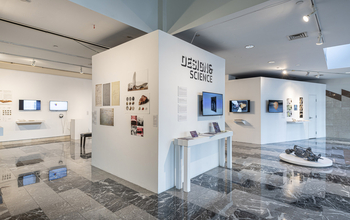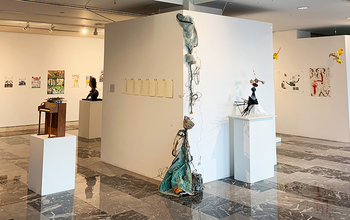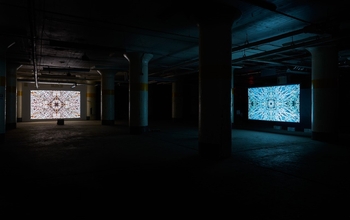In the exhibition SOCIUS, Rebecca Rutstein examines virus as source, visually exploring bonds that connect to this tenuous time of outbreak and reckoning. Through paint, light and sound, the artist depicts disparity and disease with clarity and control amidst an on-going pandemic. The surprising –and abounding– beauty in this work comes from deep and thorough observation of subjects that might otherwise spark fear or avoidance.
During her three-month residency at biotechnology company Integral Molecular, Rutstein worked alongside scientists observing SARS-CoV-2 using their unique Reporter Virus Particle (RVP) technology. Through this advanced process, designed to illuminate viral infection via bioluminescence, she witnessed complex communities of living cells. Translating the glowing viral choreography into luminous paintings, Rutstein creates densely packed compositions filled with structured movement. They teem with life, in stark –and purposeful– contrast to the crisp edged grid paintings in which she analyzes the same virus through data and demographics. In a shift from micro to macro, two large scale canvases depict the human cost of systemic racism. ‘Counted’ maps nationwide COVID-19 deaths by race in a range of red, white and blue squares. The pixelated canvas makes tangible the fact that this pandemic is killing people of color at higher rates. ‘Trust’ locates the conversation in the immediate community, depicting percentages of vaccinated adults within Philadelphia. Upended by the scope of the disparity, the formalist grid structure subverts abstraction and becomes highly representational.
Although Rebecca Rutstein has incorporated science and technology into her work for years, this exhibition marks the first time she has specifically confronted the body and disease. Like the SARS-CoV-2 virus it references, this new undertaking is both intimate and immense in scale. SOCIUS features seventeen paintings and an immersive light-sound sculpture – all of which were created in 2021. Working with scientists of Integral Molecular, the artist gathered a variety of source material, including a 60-hour time lapse video of living cells fluorescing as they become infected with the virus. This time lapse, created by scientist Tabb Sullivan, is the inspiration behind the exhibition’s entrancing sculpture, Sub Surficiem.
In the darkened back room of the gallery, Sub Surficiem fills a white wall with slowly spreading light, mutating color seeping through a perforated design of organic, cell-like clusters. Formatted as a panorama, the flat metallic sculpture is backlit by programmed LED lights emulating the progression of the virus over time. A central bench allows viewers to take in the ambient experience in a passive state, watching as the virus takes hold, a mesmerizing and deadly glow. The accompanying score, entitled Confluence, resonates with deep and somber tones. Over the course of five minutes, the atmospheric sound shifts along with the lights. As the time-lapse reverses, new data articulations introduce the vaccine neutralizing the spread. Harmony is restored, if only until the process repeats. The experience is meditative and moving, as it melodically cycles through hope and despair.
The score of Sub Surficiem consists of data sonified by the California-based, Mexican composer, Mauricio Rodriguez, who translated Philadelphia’s COVID-19 datasets into digital renderings of stringed instruments. Additional tracks use tactile instrumentation –recorded, percussive guitar– and feature Philly-based musician, Frank Masciocchi, who is also a lab engineer at Integral Molecular. Confluence embodies a holistic use of resources, calling on an expanded community to contribute in multiple, unexpected ways. Merging the digital and physical in collective experimentation, this orchestrated effort reflects a shared methodology of scientific and creative collaboration.
Rebecca Rutstein’s responsive research with Integral Molecular examines COVID-19 from a variety of viewpoints. Switching from the eyepiece of the microscope to the birds’ eye view of public health data, the artist examines the cellular and societal framework, allowing and then denying emotional distance. The title of the exhibition, SCIOUS, encapsulates this dichotomy. Its capitalization is reminiscent of the SARS-CoV-2 virus itself –the all-caps urgency of the pandemic– while the root word has taxonomical and scientific implications. The artist defines socius as the Latin word used to describe “bond” or “interaction” at the root of society. Socius can also connote the Deluezian theory of embodied production, where social control is maintained through individual tracking. Through this lens, Rutstein’s use of COVID-19 data hints at both the obligations and costs of citizenry. Visualizing the statistics tied to systemic racism and its deadly consequences, her large-scale paintings underscore that socius also translates as “ally.”
Despite the seriousness of its subject, SOCIUS remains a hopeful body of work. It is a continuation of Rebecca Rutstein’s long line of creative research connecting science to its human counterparts with a deeply examined reverence for the natural world.







